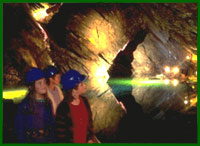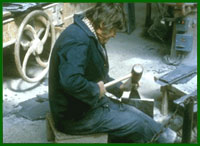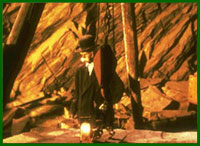|
History
and Archeology
Slate has been used
for roofing since the Romans discovered its qualities and used it at their
fort at Segontium - today known as Caernarfon. They also used carved dressed
pieces for wall hangings. The earliest Welsh use of roofing slates was
in the 12th century at a site that appears to have been fortified by Owain
Gwynedd, Prince of North Wales. King Edward 1st architect certainly used
slates to roof Conway Castle. Slate really started to be used in commercial
quantities during the industrial revolution for roofing the vast numbers
of new houses that were being built all across the country. Then it was
exported around the world. Welsh slate was a quality product.
 The
Llechwedd complex of slate mines was central to this production of slate.
It comprises several workings that were historically known as separate
entities such as Diffwys, Bowydd, Maenofferen as well as Llechwedd its
self. Slate was worked here at Diffws (1 mile east of the Llechwedd tourist
complex) in 1775 but the others started on the 19th century. Blaenau Ffestiniog's
slate remained hidden for a long time because the 30º angle of the
beds left them only outcropping in patches; elsewhere the beds are near
vertical or horizontal. This meant that the slates had to be mined until
the recent modern machinery allowed open cast operations. The
Llechwedd complex of slate mines was central to this production of slate.
It comprises several workings that were historically known as separate
entities such as Diffwys, Bowydd, Maenofferen as well as Llechwedd its
self. Slate was worked here at Diffws (1 mile east of the Llechwedd tourist
complex) in 1775 but the others started on the 19th century. Blaenau Ffestiniog's
slate remained hidden for a long time because the 30º angle of the
beds left them only outcropping in patches; elsewhere the beds are near
vertical or horizontal. This meant that the slates had to be mined until
the recent modern machinery allowed open cast operations.
Enormous caverns were
carved out underground, a process that was made possible through layers
of igneous rocks that provided secure roofs. Eventually there were 16
floors at Llechwedd all identified in relation to the point at where the
slate was found in 1849. This became known as floor 1 and the subsequent
floors were numbered upwards (1-7) and downwards (A-I) giving a vertical
distance of about 305 metres underground. Tracks were laid to help move
out the great blocks of slate to the surface and to the surface where
they were trimmed and split. Professional slate workers can produce great
numbers of slate from the slabs using a chisel. It is commonplace for
splitters to produce about 35 sheets per inch and at the London Exhibition
of 1862 the founder of Llechwedd, John Greaves, won a medal with slabs
10ft long and 1 ft wide but only 1/16 of an inch thick.
 The
slates had to be transported to the coast where they were shipped around
the country and overseas. At first this was done by hauling them down
the toll road to the quays at Tanybwlch. But the erection of a land reclamation
embankment across the mouth of the River Glaslyn in 1813 scoured a navigable
channel across the Dwyryd estuary. This soon led to the creation of Port
Madoc and in 1836 a narrow gauge railway, the Ffestiniog Railway, opened
up to link the harbour with Blaunau Ffestiniog. 1851 the office was moved
from Llechwedd to new wharfs in the harbour. About 260 ships were built
at Port Madoc with most of constructed to carry slate to the new markets
opening up everywhere. In 1869 the Cambrian Railway came to Minffordd
enabling slate to be reloaded to standard gauge stock and taken by train
to the major cities. The London and North Western Railway cut through
from the Conwy Valley in 1879 providing Deganwy as an alternative harbour.
Finally the Bala and Ffestiniog Railway, later part of the Great Western
Railway, arrived at the town. The
slates had to be transported to the coast where they were shipped around
the country and overseas. At first this was done by hauling them down
the toll road to the quays at Tanybwlch. But the erection of a land reclamation
embankment across the mouth of the River Glaslyn in 1813 scoured a navigable
channel across the Dwyryd estuary. This soon led to the creation of Port
Madoc and in 1836 a narrow gauge railway, the Ffestiniog Railway, opened
up to link the harbour with Blaunau Ffestiniog. 1851 the office was moved
from Llechwedd to new wharfs in the harbour. About 260 ships were built
at Port Madoc with most of constructed to carry slate to the new markets
opening up everywhere. In 1869 the Cambrian Railway came to Minffordd
enabling slate to be reloaded to standard gauge stock and taken by train
to the major cities. The London and North Western Railway cut through
from the Conwy Valley in 1879 providing Deganwy as an alternative harbour.
Finally the Bala and Ffestiniog Railway, later part of the Great Western
Railway, arrived at the town.
 New
skills were needed to speed slate production and the owner, J.W.Greaves,
was at the forefront of innovation. He devised his own sawing table and
a slate-dressing engine that is still used whenever slates need trimming
for roofing. This high technology of its era, the railway and the new
harbour made 1850 the turning point for Greaves and Llechwedd. In this
year 1,128 tons of finished roofing slates, with a value of £2,114,
were sold, putting Llechwedd on a level with the big producers. New
skills were needed to speed slate production and the owner, J.W.Greaves,
was at the forefront of innovation. He devised his own sawing table and
a slate-dressing engine that is still used whenever slates need trimming
for roofing. This high technology of its era, the railway and the new
harbour made 1850 the turning point for Greaves and Llechwedd. In this
year 1,128 tons of finished roofing slates, with a value of £2,114,
were sold, putting Llechwedd on a level with the big producers.
Hydro-electric generation
was installed at Llechwedd in 1890 and in 1904 this was improved by harnessing
the power from two lakes above the quarry. They remain in use, occasionally
feeding power into the national grid.
|


 The
Llechwedd complex of slate mines was central to this production of slate.
It comprises several workings that were historically known as separate
entities such as Diffwys, Bowydd, Maenofferen as well as Llechwedd its
self. Slate was worked here at Diffws (1 mile east of the Llechwedd tourist
complex) in 1775 but the others started on the 19th century. Blaenau Ffestiniog's
slate remained hidden for a long time because the 30º angle of the
beds left them only outcropping in patches; elsewhere the beds are near
vertical or horizontal. This meant that the slates had to be mined until
the recent modern machinery allowed open cast operations.
The
Llechwedd complex of slate mines was central to this production of slate.
It comprises several workings that were historically known as separate
entities such as Diffwys, Bowydd, Maenofferen as well as Llechwedd its
self. Slate was worked here at Diffws (1 mile east of the Llechwedd tourist
complex) in 1775 but the others started on the 19th century. Blaenau Ffestiniog's
slate remained hidden for a long time because the 30º angle of the
beds left them only outcropping in patches; elsewhere the beds are near
vertical or horizontal. This meant that the slates had to be mined until
the recent modern machinery allowed open cast operations.  The
slates had to be transported to the coast where they were shipped around
the country and overseas. At first this was done by hauling them down
the toll road to the quays at Tanybwlch. But the erection of a land reclamation
embankment across the mouth of the River Glaslyn in 1813 scoured a navigable
channel across the Dwyryd estuary. This soon led to the creation of Port
Madoc and in 1836 a narrow gauge railway, the Ffestiniog Railway, opened
up to link the harbour with Blaunau Ffestiniog. 1851 the office was moved
from Llechwedd to new wharfs in the harbour. About 260 ships were built
at Port Madoc with most of constructed to carry slate to the new markets
opening up everywhere. In 1869 the Cambrian Railway came to Minffordd
enabling slate to be reloaded to standard gauge stock and taken by train
to the major cities. The London and North Western Railway cut through
from the Conwy Valley in 1879 providing Deganwy as an alternative harbour.
Finally the Bala and Ffestiniog Railway, later part of the Great Western
Railway, arrived at the town.
The
slates had to be transported to the coast where they were shipped around
the country and overseas. At first this was done by hauling them down
the toll road to the quays at Tanybwlch. But the erection of a land reclamation
embankment across the mouth of the River Glaslyn in 1813 scoured a navigable
channel across the Dwyryd estuary. This soon led to the creation of Port
Madoc and in 1836 a narrow gauge railway, the Ffestiniog Railway, opened
up to link the harbour with Blaunau Ffestiniog. 1851 the office was moved
from Llechwedd to new wharfs in the harbour. About 260 ships were built
at Port Madoc with most of constructed to carry slate to the new markets
opening up everywhere. In 1869 the Cambrian Railway came to Minffordd
enabling slate to be reloaded to standard gauge stock and taken by train
to the major cities. The London and North Western Railway cut through
from the Conwy Valley in 1879 providing Deganwy as an alternative harbour.
Finally the Bala and Ffestiniog Railway, later part of the Great Western
Railway, arrived at the town.  New
skills were needed to speed slate production and the owner, J.W.Greaves,
was at the forefront of innovation. He devised his own sawing table and
a slate-dressing engine that is still used whenever slates need trimming
for roofing. This high technology of its era, the railway and the new
harbour made 1850 the turning point for Greaves and Llechwedd. In this
year 1,128 tons of finished roofing slates, with a value of £2,114,
were sold, putting Llechwedd on a level with the big producers.
New
skills were needed to speed slate production and the owner, J.W.Greaves,
was at the forefront of innovation. He devised his own sawing table and
a slate-dressing engine that is still used whenever slates need trimming
for roofing. This high technology of its era, the railway and the new
harbour made 1850 the turning point for Greaves and Llechwedd. In this
year 1,128 tons of finished roofing slates, with a value of £2,114,
were sold, putting Llechwedd on a level with the big producers.